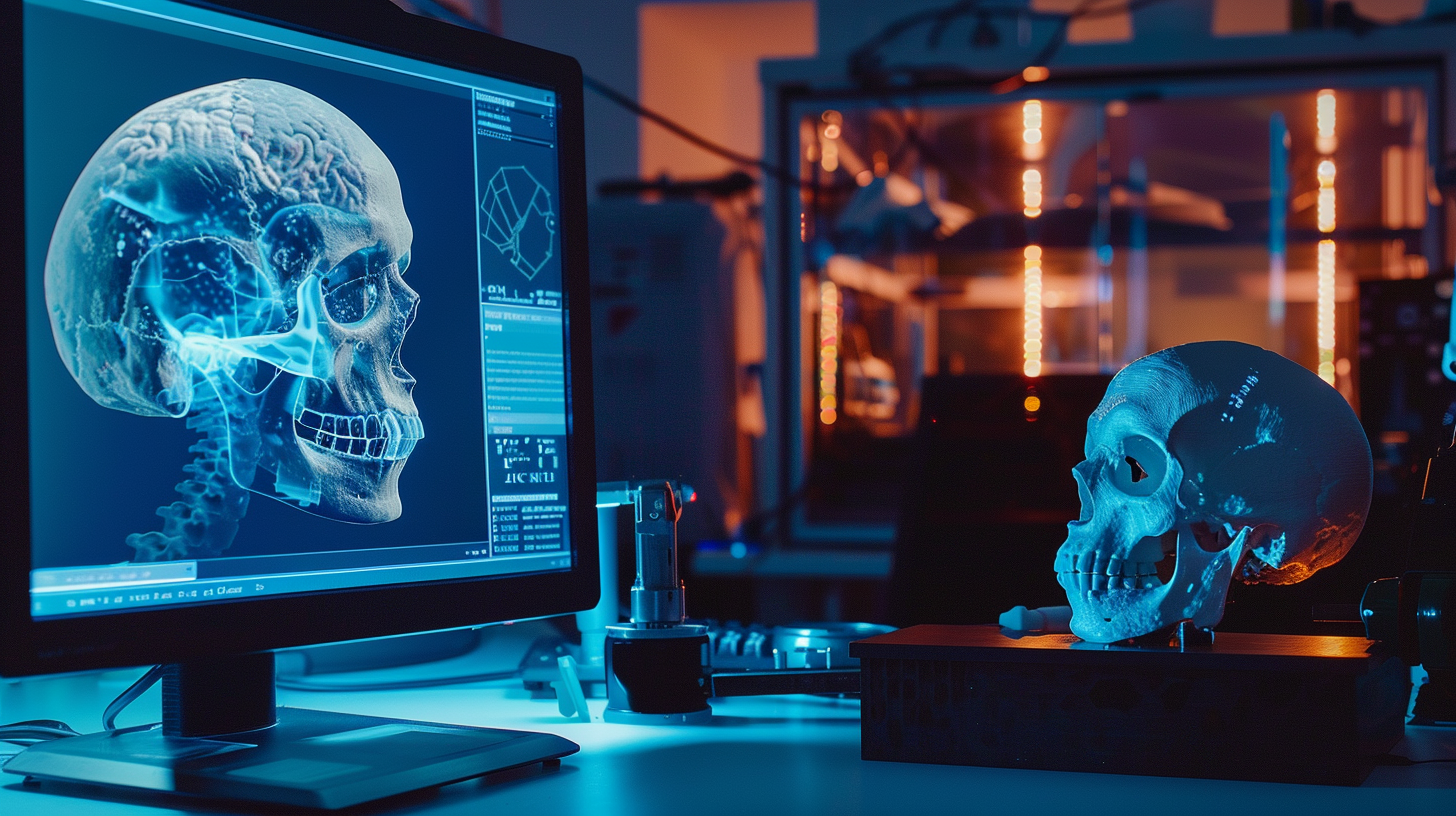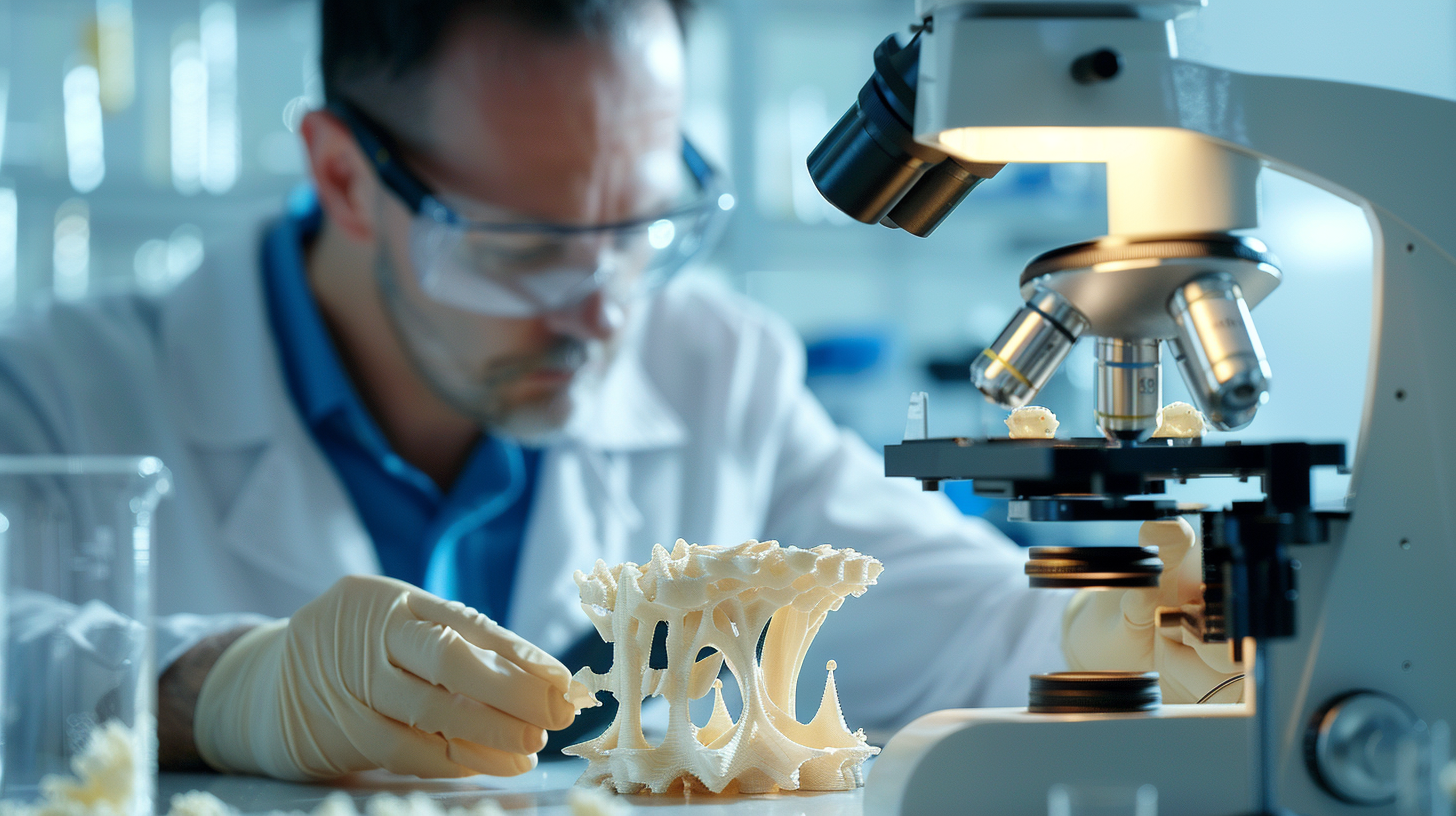
산업용 3D프린팅 기술이 식품 용기, 의료기기, 웨어러블 디바이스 등 인체와 직접 접촉하는 최종 부품(End-use Parts) 제작으로 그 활용 범위를 빠르게 넓혀가고 있습니다. 이는 제조업의 새로운 가능성을 열어주는 동시에, 과거에는 없었던 새로운 차원의 품질 검증과 규제 준수의 중요성을 부각시키고 있습니다.
단순히 ‘인증된 소재’를 사용하는 것만으로는 최종 제품의 안전을 보장할 수 없습니다. 성공적인 제품화를 위해서는 설계 소프트웨어부터 프린팅 공정, 후처리, 멸균에 이르기까지 전체 워크플로우에 대한 깊이 있는 이해와 체계적인 접근이 필수적입니다. 이 글에서는 인체 접촉을 전제로 한 산업용 3D프린팅 부품에 적용되는 핵심 규제 환경, 소재 과학, 그리고 공정 검증의 모든 것을 분석하고, 글룩이 어떻게 이 복잡한 요구사항을 충족시키고 있는지 살펴보겠습니다.
'인증 소재'가 '인증 부품'을 보장하지 않는 이유

가장 먼저 이해해야 할 핵심은 ‘인증 소재(certified material)’와 ‘인증 부품(certified part)’ 사이에는 본질적인 차이가 존재한다는 점입니다. 예를 들어, FDA 식품 등급 인증을 받은 필라멘트를 사용했다고 해서, 그 결과물이 자동으로 식품에 안전한 부품이 되는 것은 아닙니다.
3D프린팅은 재료를 녹이고, 경화하고, 층층이 쌓아 올리는 복잡한 물리·화학적 공정을 거칩니다. 이 과정에서 다음과 같은 ‘규제 준수 격차(compliance gap)’가 발생할 수 있습니다.
- 물리적 위험: FDM 방식의 레이어 라인(층간 결) 사이에는 미세한 틈이 존재하며, 이는 박테리아가 서식하기 좋은 환경이 될 수 있습니다.
- 화학적 오염: 프린터 노즐의 마모로 인해 금속 입자가 최종 부품에 혼입되거나, 소재에 포함된 특정 착색제가 고온에서 용출될 수 있습니다.
- 공정의 일관성 부재: 동일한 인증 소재를 사용하더라도, 어떤 프린터로, 어떤 파라미터 값으로, 어떤 후처리 과정을 거쳐 제작했는지에 따라 최종 부품의 생체적합성과 기계적 물성은 크게 달라질 수 있습니다.
따라서 진정한 의미의 ‘인증 부품’을 제작하기 위해서는 소재뿐만 아니라, 설계-출력-후처리에 이르는 제조 워크플로우 전체가 통제되고 검증되어야 합니다. 이것이 바로 글룩과 같은 전문 산업용 3D프린팅 서비스 기업의 역할이 중요한 이유입니다.
인체 접촉 애플리케이션별 규제 프레임워크

1. 식품 접촉(Food Contact): FDA와 EU 규정
3D프린팅으로 식품 용기, 주방 도구, 포장용 고정구 등을 제작할 때는 엄격한 식품 접촉 규제를 준수해야 합니다.
- 미국 FDA 규정: 식품과 접촉하는 모든 물질은 ‘일반적으로 안전하다고 인정되는 물질(GRAS)’이거나, 식품 접촉 신고(FCN) 절차를 통해 승인되어야 합니다. PETG는 가장 일반적인 식품 접촉용 필라멘트로, 21 CFR 177.1630 규정을 준수하는 제품들이 시판되고 있습니다.
- EU 프레임워크 규정 (EC) 10/2011: 유럽연합은 규정에 명시된 물질만 사용할 수 있는 "허용 목록(Positive List)" 원칙을 따릅니다. 특히 소재에서 식품으로 특정 물질이 얼마나 빠져나오는지를 측정하는 용출 시험이 핵심이며, 총 용출 한계는 10 mg/dm²로 설정되어 있습니다. EOS의 PA 2200(나일론) 소재는 이 규정에 따라 식품 접촉용으로 인증되었지만, 고알코올 식품에는 사용이 제한되는 등 식품 종류에 따른 위험 기반 접근을 보여줍니다.
2. 의료 및 생체적합성(Medical & Biocompatibility): ISO 13485와 ISO 10993
수술 가이드, 해부학적 모델, 보철물 등 의료기기 제작에는 더욱 엄격한 품질 경영과 생체적합성 평가가 요구됩니다.
- ISO 13485 (품질 경영 시스템): 이는 의료기기 제조를 위한 국제 품질 경영 시스템(QMS) 표준입니다. Formlabs, Stratasys와 같은 주요 소재 공급업체들은 ISO 13485 인증 시설에서 의료 등급 소재를 생산함으로써, 오염 방지, 로트 간 일관성, 추적 가능성을 보장합니다. 이는 단순한 소재 판매를 넘어, ‘규제된 공급망의 한 구성요소’를 제공하는 것으로, 의료기기 제조사는 전체 공급망에 대한 책임을 지기 때문에 공급업체의 QMS 인증 여부가 필수 평가 항목이 됩니다.
- ISO 10993 (생체적합성 평가): 최종적으로 프린트된 부품이 인체에 미치는 영향을 평가하는 표준입니다. 피부 접촉, 점막 접촉, 단기 조직 접촉, 영구 이식 등 접촉 유형과 기간에 따라 요구되는 시험 항목이 달라집니다. Formlabs의 BioMed 레진 포트폴리오나 Stratasys의 MED610과 같은 소재들은 ISO 10993의 주요 항목 및 USP Class VI 시험을 통과하여 특정 의료 목적에 대한 적합성을 입증합니다.
3. 고성능 폴리머(PEEK): 영구 이식형 애플리케이션
두개골 임플란트, 척추 케이지 등 인체에 영구적으로 이식되는 고위험 의료기기에는 PEEK와 같은 최고 등급의 고성능 폴리머가 사용됩니다. 3D Systems는 Evonik의 PEEK 소재를 사용하여 세계 최초로 3D프린팅 PEEK 두개골 임플란트에 대한 FDA 510(k) 승인을 받았습니다. 여기서 중요한 점은, 단지 소재나 제품만이 아니라 소프트웨어, 프린터, 소재, 공정을 포함한 전체 워크플로우가 하나의 시스템으로 승인되었다는 것입니다. 이는 산업용 3D프린팅 규제의 미래가 나아갈 방향을 명확히 보여줍니다.
설계 제약조건으로서의 중요성

의료용 3D프린팅 부품은 최종 사용 전 반드시 멸균 과정을 거쳐야 합니다. 하지만 멸균 방법은 단순한 최종 단계가 아니라, 소재 선택과 설계를 좌우하는 핵심 ‘설계 제약조건’입니다.
- 주요 멸균 방법: 증기 멸균(오토클레이브), 에틸렌옥사이드(EtO) 가스, 감마선 조사가 주로 사용됩니다.
- 소재 호환성: PLA나 PETG 같은 저온 플라스틱은 고온의 오토클레이브에서 변형될 수 있습니다. 반면 PEEK나 일부 고성능 레진, Stratasys의 ABS-M30i 같은 소재는 오토클레이브나 감마선 멸균에도 안정적입니다.
- 설계의 영향: 병원에서 오토클레이브 멸균이 필수라면, 소재는 자연스럽게 PEEK 등으로 제한됩니다. 또한, PEEK라도 얇은 구조물은 멸균 시 변형될 수 있으므로, 최소 벽 두께 등 설계 요소 역시 멸균 스트레스를 견딜 수 있도록 처음부터 고려되어야 합니다.
결론적으로, 안전하고 효과적인 최종 제품을 만들기 위해서는 설계-소재-후처리-멸균이 분리될 수 없는 통합된 시스템으로 관리되어야 합니다.
규제의 미래 - 공정, 소프트웨어, 그리고 지속가능성

산업용 3D프린팅 인증은 이제 소재 차원을 넘어 전체 디지털 워크플로우를 포함하는 방향으로 진화하고 있습니다.
- 공정 검증 (ISO/ASTM 52920): 이 표준은 데이터 준비부터 원료 보관, 출력, 후처리, 품질 관리에 이르는 생산 현장 전체의 공정 능력을 인증하는 프레임워크입니다. 항공우주, 의료 분야의 연속 생산체계 확보를 위해 공급업체의 52920 인증 요구가 점차 확대될 것입니다.
- 의료기기 소프트웨어 (SaMD): CT, MRI 데이터를 프린팅 가능한 설계 파일로 변환하는 소프트웨어는 진단 및 치료 계획에 사용될 경우, **SaMD(Software as a Medical Device)**로 분류되어 FDA 및 EU MDR의 규제를 받습니다.
- 지속가능성: 재료 낭비 최소화, 경량화를 통한 에너지 절감 등 산업용 3D프린팅의 친환경적 특성이 부각됨에 따라, 재활용 가능성, 바이오 기반 소재 사용, 전 과정 평가(LCA) 등이 새로운 인증 요구 항목으로 부상할 것입니다.
미래의 규제 환경은 소재, 공정, 소프트웨어, 지속가능성을 아우르는 다층적 인증 스택으로 구성될 것입니다. 규제는 더 이상 혁신의 장애물이 아니라, 신뢰를 구축하고 산업용 3D프린팅 기술의 광범위한 채택을 가능하게 하는 촉진제가 될 것입니다.
GLUCK은 대량생산이 가능한 산업용 3D프린팅 서비스 기업입니다.
작은 아이디어를 반복 가능한 생산성으로 전환해, 현실 가능한 제조 솔루션을 제공합니다.
지금 글룩에 문의해 보세요.
📩 제작 및 상담 문의: https://glucklab.com/
3D Printed Parts for Human Contact: Regulation, Certification, and the Future of the Industry

As industrial 3D printing technology expands its applications to products that come into direct contact with the human body—such as food containers, medical devices, and wearable devices—the importance of appropriate regulation and quality verification is becoming more critical than ever.
Simply using a 'certified material' is not enough to guarantee the safety of the final product. To achieve successful commercialization, a systematic approach and deep understanding of the entire workflow—from design software and the printing process to post-processing and sterilization—is essential. This article will provide an in-depth analysis of the key regulatory environments, material science, and process validation applied to industrial 3D printing parts intended for human contact, and explore how GLUCK is meeting these complex requirements.
Key Concept: Why a 'Certified Material' Does Not Guarantee a 'Certified Part'

The most crucial concept to understand is that there is a fundamental difference between a 'certified material' and a 'certified part.' For example, using a filament that has received FDA food-grade certification does not automatically make the resulting object a food-safe part.
3D printing involves complex physical and chemical processes of melting, curing, and layering materials. During this process, a 'compliance gap' can occur in the following ways:
- Physical Hazards: The layer lines in FDM parts create microscopic crevices that can become breeding grounds for bacteria.
- Chemical Contamination: Wear and tear on a printer nozzle can introduce metal particles into the final part, or certain colorants in a material can leach out at high temperatures.
- Lack of Process Consistency: Even when using the same certified material, the biocompatibility and mechanical properties of the final part can vary greatly depending on which printer, what parameter settings, and which post-processing methods were used.
Therefore, to produce a truly 'certified part,' the entire manufacturing workflow—from design and printing to post-processing—must be controlled and validated. This is precisely why the role of a professional industrial 3D printing service provider like GLUCK is so important.
Regulatory Frameworks by Human Contact Application

1. Food Contact: FDA and EU Regulations
When 3D printing food containers, kitchen tools, or packaging fixtures, strict food contact regulations must be followed.
- U.S. FDA Regulations: Any substance intended to come into contact with food must either be 'Generally Recognized as Safe (GRAS)' or be approved through the Food Contact Notification (FCN) process. PETG is the most common food-contact filament, with products on the market that comply with regulation 21 CFR 177.1630.
- EU Framework Regulation (EC) 10/2011: The European Union follows a "Positive List" principle, where only substances listed in the regulation may be used. Migration testing, which measures how much of a substance leaches from the material into food, is key. The overall migration limit is set at 10 mg/dm². EOS's PA 2200 (nylon) material is certified for food contact under this regulation, but its use is restricted with high-alcohol foods, demonstrating a risk-based approach depending on the food type.
2. Medical & Biocompatibility: ISO 13485 and ISO 10993
The manufacturing of medical devices like surgical guides, anatomical models, and prosthetics requires even stricter quality management and biocompatibility evaluation.
- ISO 13485 (Quality Management System): This is the international QMS standard for medical device manufacturing. Major material suppliers like Formlabs and Stratasys produce their medical-grade materials in ISO 13485 certified facilities, ensuring contamination prevention, lot-to-lot consistency, and traceability. This goes beyond simply selling a material; it means providing a 'component of a regulated supply chain.' Medical device manufacturers are responsible for their entire supply chain, making a supplier's QMS certification a mandatory evaluation criterion.
- ISO 10993 (Biocompatibility Evaluation): This standard assesses the effects of a final printed part on the human body. The required tests vary depending on the type and duration of contact, such as skin contact, mucosal contact, short-term tissue contact, or permanent implantation. Materials like Formlabs' BioMed resin portfolio or Stratasys' MED610 have passed key sections of ISO 10993 and USP Class VI tests, proving their suitability for specific medical applications.
3. High-Performance Polymers (PEEK): Permanent Implantable Applications
For high-risk medical devices that are permanently implanted in the human body, such as cranial implants or spinal cages, the highest grade of high-performance polymers like PEEK is used. 3D Systems, using Evonik's PEEK material, received the world's first FDA 510(k) clearance for a 3D-printed PEEK cranial implant. What is significant here is that not just the material or the product, but the entire workflow—including the software, printer, material, and process—was cleared as a single system. This clearly shows the future direction of industrial 3D printing regulation.
Sterilization: Its Importance as a Design Constraint

3D-printed medical parts must undergo sterilization before final use. However, the sterilization method is not just a final step; it is a key 'design constraint' that dictates material selection and design.
- Main Sterilization Methods: Steam sterilization (autoclave), ethylene oxide (EtO) gas, and gamma irradiation are commonly used.
- Material Compatibility: Low-temperature plastics like PLA or PETG can warp in a high-temperature autoclave. In contrast, materials like PEEK, certain high-performance resins, and Stratasys' ABS-M30i are stable under autoclave or gamma sterilization.
- Design Impact: If a hospital requires autoclave sterilization, the material choice is automatically limited to materials like PEEK. Furthermore, even PEEK can deform during sterilization if the structure is too thin, meaning design elements like minimum wall thickness must be considered from the start to withstand sterilization stress.
In conclusion, design, material, post-processing, and sterilization must be managed as an inseparable, integrated system to create a safe and effective final product.
The Future of Regulation: Process, Software, and Sustainability

Industrial 3D printing certification is evolving beyond the material level to encompass the entire digital workflow.
- Process Validation (ISO/ASTM 52920): This standard provides a framework for qualifying the entire production site process, from data preparation and material handling to printing, post-processing, and quality control. This is becoming an essential requirement for ensuring a continuous production system in the aerospace and medical fields.
- Software as a Medical Device (SaMD): Software that converts medical images like CT and MRI scans into printable design files can be classified as SaMD if used for diagnosis or treatment planning, making it subject to FDA and EU MDR regulations.
- Sustainability: As industrial 3D printing's eco-friendly characteristics—such as minimal material waste and energy savings through lightweighting—are highlighted, new certification requirements related to recyclability, use of bio-based materials, and Life Cycle Assessment (LCA) will emerge.
The future regulatory landscape will consist of a multi-layered certification stack encompassing materials, processes, software, and sustainability. Regulation is no longer an obstacle to innovation but a catalyst that builds trust and enables the widespread adoption of industrial 3D printing technology.
GLUCK is an industrial 3D printing service company capable of mass production.
We transform small ideas into repeatable productivity, providing realistic manufacturing solutions.
Contact GLUCK today.
📩 For production and consultation inquiries: https://glucklab.com/
#GLUCK #글룩 #3D프린팅 #산업용3D프린팅 #SLA3D프린팅 #대량생산 #DfAM #3D설계 #3D프린팅산업 #3D프린터 #3D모델링 #3D프린팅가격 #3D프린팅업체 #금형제작 #금형 #사출 #몰드제작 #3D프린팅견적 #3D출력 #MassProduction #3DPrinting #LargescaleProduction #AdditiveManufacturing #SLAtechnology #ManufacturingInnovation #DigitalTransformation #SmartManufacturing #3D프린팅인증 #생체적합성 #의료용3D프린팅 #ISO13485 #FDA #Biocompatibility #Medical3DPrinting #3DPrintingRegulation #ISO10993 #CertifiedMaterials
'인사이트 (Insights)' 카테고리의 다른 글
| 3D스캐닝과 3D프린팅: 현실을 데이터로, 데이터를 현실로 만드는 기술 (0) | 2025.09.22 |
|---|---|
| 3D프린팅 기반 조명 제조 전략, 설계 유연성과 생산 효율을 동시에! (1) | 2025.09.19 |
| 자연을 닮은 3D프린팅, 생체모방설계를 제시합니다. (0) | 2025.09.18 |
| 특별한 순간을 위한 맞춤 트로피, 산업용 SLA 3D프린팅의 힘 (0) | 2025.09.18 |
| 3D프린팅, 예술의 새로운 캔버스: 기술이 빚어내는 창작의 혁신 (0) | 2025.09.17 |
